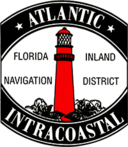Unit:Florida Inland Navigation District
The mission of the Florida Inland Navigation District is to perform the functions of the "local sponsor" of the Atlantic Intracoastal Waterway project in Florida, a State/Federal navigation project.
Hierarchy
Affiliations
Parent Organizations: Governor
Subsidiaries: Intracoastal Waterway
Partners: US Army Corps of Engineers
Contact
Disclaimer: This information is for organizational purposes only. The presence of an Organization's information on this Website should not be viewed as an endorsement of the Website by the Organization. Nor should an Organization's presence on the Website be viewed as an endorsement of the Organization by the Website.
Overview
The Florida Inland Navigation District was created by the Florida Legislature in 1927, by Chapter 12026 Laws of Florida to be the state sponsor of the Atlantic Intracoastal Waterway in Florida. This law authorized the Navigation District to purchase the existing East Coast Canal that had previously been constructed by private interests and which ran from Jacksonville to Miami. The Navigation District purchased the Canal in 1928 and it became the public waterway known as the Atlantic Intracoastal Waterway in Florida.
Today, the Navigation District's responsibilities can be found under Chapter 374 of the Florida Statutes. This law states that the principal function of the Navigation District as the state sponsor of the Waterway is to furnish to the United States of America, the federal sponsor of the waterway, all lands required by them to construct, operate and maintain the Waterway. Additionally, the Legislature authorized the Navigation District to perform Waterway projects on behalf of the United States as well as working with other governmental agencies to provide waterway access for our mutual constituents.
The Navigation District consists of the twelve counties along the east coast of Florida from Nassau through Miami-Dade County. The Governor appoints a commissioner from each county to serve on the Navigation District's Board of Commissioners. The Board levies a real property tax on all property within the District's boundaries to generate the funds necessary to fulfill the District's responsibilities.
Missions
The Florida Inland Navigation District has two primary missions:
(1) to perform the functions of the "local sponsor" of the Atlantic Intracoastal Waterway project and a portion of the Okeechobee Waterway project in Florida, both of which are State/Federal navigation projects, and
(2) provide assistance to other governments to develop waterway access and improvement projects. As the local sponsor of the Waterway, the District provides all lands required for the navigation project including rights of way and lands for the management of dredged materials removed from the waterway channel during dredging activities.
History
The Florida Inland Navigation District was created by the Florida Legislature in 1927 through Chapter 12026, Special Acts of 1927. The District was created to meet the conditions of the Rivers and Harbor Act approved by Congress on January 21, 1927 authorizing the construction, operation and maintenance of Intracoastal Waterway in Florida. These acts required the District to: serve as the “local sponsor” of the Waterway; acquire the necessary rights of way and the privately owned waterway known as Florida East Coast Canal and transfer them free of cost to the United States, and; furnish suitable areas for deposit of dredged materials in connection with the work and its subsequent maintenance.
